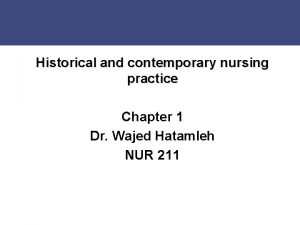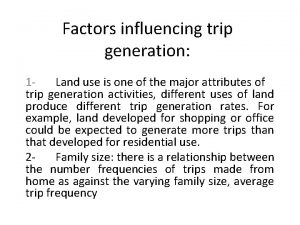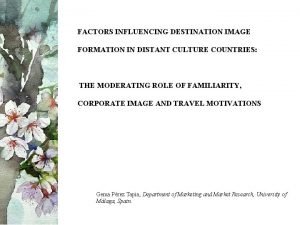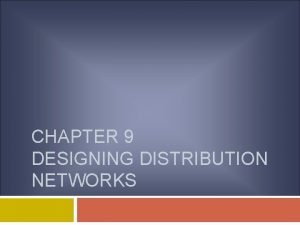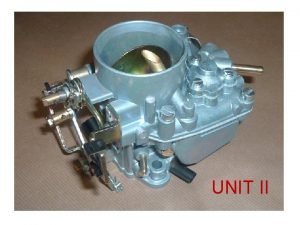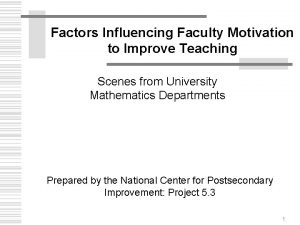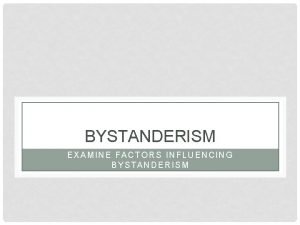Meaning Definition Types Factors influencing Improve of test






















- Slides: 22


� Meaning � Definition � Types � Factors influencing � Improve of test

� Reliability is one of the important characteristics of any test. � It refer to the precision or accuracy of the measurement of score. � Reliability protocol. refers to the stability of a test measure or

� Rosenthal(1991): Reliability is a major concern when a psychological test is used to measure some attribute or behaviour. � Anastasi (1968): Reliability refers to the consistency of scores obtained by the same individuals when reexamined with test on different occasions, or with different sets of equivalent items, or under other variable examining conditions.

� Three important types ◦ Test –Retest Reliability ◦ Split – half or Internal Consistency Reliability ◦ Parallel forms reliability or Equivalent - forms

� In test –retest reliability the single form of the test is administered twice on the sample with a reasonable time gap. � In this way two administration of the same form of the two independent sets of scores. � The two sets, when correlated, give the value of the reliability coefficient.

Same Test Same Sample Different Times

� Measure instrument at two times for multiple persons. � Compute � Assumes correlation between the two measures. there is no change in the underlying trait between time 1 and time 2.

� Contributing factors: ◦ (1) Clear instructions for administrators, research participants, and raters ◦ (2) Tasks/questions in participants’ first language or target language at appropriate level of difficulty ◦ (3) Unambiguously phrased tasks/questions

� Other � It name Internal Consistency reliability indicates the homogeneity of the test � This method the test is divided into two equal or nearly halves � Common way of this test is the odd-even method

© Thatchinamoorthy, Ph. D scholar

� Indicates that subjects’ scores on some trials consistently match their scores on other trials

� Contributing factors: ◦ (1) Careful item writing, guided by item specifications ◦ (2) Field test and item analysis ◦ (3) Construction of tests with reference to item performance

� This reliability various names such as, ◦ Alternative- forms reliability ◦ Equivalent –forms reliability ◦ Comparable – forms reliability

� The alternative forms technique to estimate reliability is similar to the test retest method, except that different measures of a behaviour (rather than the same measure) are collected at different times. � If the correlation between the alternative forms is low, it could indicate that considerable measurement error is present, because two different scales were used.


� Contributing factors: ◦ (1) The development of equivalent forms from specifications that describe tool content ◦ (2) Trial of tools before data collection to ensure equivalence

� Group Variability � Guessing by the examinees � Environmental Conditions

�When the group of examinees being tested is homogenous in ability, the reliability of the test scores is likely to be lowered. � But when the examinees vary widely in their range of ability, that is, the group of examinees is a heterogeneous one, the reliability of the test scores is likely to be high.

� Guessing �In in a test is an important source of unreliability. two alternative response options there is a 50 % chance of answering the items correctly on the basis of the guess.

� Testing environment should be uniform � Arrangement should be such that light, sound, and other comforts are equal and uniform to all the examinees. � Otherwise scores it will tend to lower the reliability of the test

� The group of examinees should be heterogeneous, that is, the examinees should vary widely in their ability or trait being measured. � Items � Test should be homogenous. should preferably be a longer one. � Items should be discriminatory ones.
 Define dynamic personality
Define dynamic personality Oxidation weathering
Oxidation weathering Wages and salaries administration
Wages and salaries administration Physical factors influencing agriculture
Physical factors influencing agriculture Vertical
Vertical Historical and contemporary nursing practice
Historical and contemporary nursing practice Factors influencing trip attraction
Factors influencing trip attraction Factors influencing pricing
Factors influencing pricing A model of destination image formation
A model of destination image formation Factors that can influence communication
Factors that can influence communication Factors influencing maternal health
Factors influencing maternal health Systemic factors influencing wound healing
Systemic factors influencing wound healing Factors influencing faculty staff relationship
Factors influencing faculty staff relationship Factors influencing workshop layout
Factors influencing workshop layout Role of network design in supply chain
Role of network design in supply chain Physical factors influencing agriculture
Physical factors influencing agriculture Factor affecting consensus
Factor affecting consensus Types of chemical weathering
Types of chemical weathering Factors influencing distribution network
Factors influencing distribution network Factors affecting oxygen administration
Factors affecting oxygen administration The history of farming
The history of farming Nozzle lip is provided in simple carburettor
Nozzle lip is provided in simple carburettor Factors influencing t&d
Factors influencing t&d





